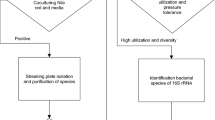Abstract
For the survival of individual isolates of gram-negative bacteria Pseudomonas putida, Achromobacter xylosoxidans, and the gram-positive bacterium Bacillus megaterium, in an environment polluted with crude oil products, the production of catalases exhibiting both catalase and dianisidine-peroxidase activity is important. Electrophoretic resolution of cell-free extracts of aerobically grown strains in Luria–Bertani medium during exponential phase revealed distinctive expression of catalatic and peroxidatic activities detected with 3,3′-diaminobenzidine tetrahydrochloride. A considerable diversity in microbial catalase and peroxidase responses to 20 or 40 mM H2O2 stress, resulted from hydroperoxidase’s variant of original isolates, indicating an environmental selective pressure. However, catalase was important for the adaptation of cultures to high concentration of 60 mM H2O2. Appreciable differences in the sensitivity to toxic effect of H2O2 (20 or 40 mM) treatment between individual isolates and their adapted variants during growth were observed until the middle of exponential phase, but they were insignificant at the entry to stationary phase. Isolates also exhibited a considerable diversity in catalases responses to phenolic contaminants 1 and 2 mM o- or p-phenylenediamine. Catalase activity of bacterium P. putida was visibly stimulated only by p-phenylenediamine and not by its positional isomer o-PDA. This study contributes to a better understanding of the role catalases play in bacterial responses to a polluted environment.





Similar content being viewed by others
References
Barret CH, Dodgson KS, White GF, Payne WJ (1980) Preliminary observations on alcohol dehydrogenases in Comamonas terrigena that exhibit stereospecificity towards secondary alcohols. J Biochem 187:703–709
Boháčová V, Zámocký M, Godočíková J, Bučková M, Polek B (2006) The expression and diversity of catalases in isolates of genus Comamonas in response to the oxidative stress of a polluted environment. Curr Microbiol 53:430–434
Boyd S (1982) Adsorption of substituted phenols in soil. Soil Sci 134:337–343
Bradford MM (1976) A rapid and sensitive method for the quantitation of microgram quantities of protein utilizing the principle of protein–dye binding. Anal Biochem 72:248–250
Bučková M, Godočíková J, Šimonovičová A, Polek B (2005) Production of catalases by Aspergillus niger isolates as a response to pollutant stress by heavy metals. Curr Microbiol 50:175–179
Bučková M, Godočíková J, Polek B (2007) Responses in the mycelial growth of Aspergillus niger isolates to arsenic contaminated environments and their resistance to exogenic metal stress. J Basic Microbiol 47:295–300
Claiborne A, Fridovich I (1979) Purification of the o-dianisidine peroxidase from Escherichia coli B. Physicochemical characterization and analysis of its dual catalatic and peroxidatic activities. J Biol Chem 254:4245–4252
Dowds BCA, Murphy P, McConnel DJ, Devine KM (1987) Relationship among oxidative stress, growth cycle, and sporulation in Bacillus subtilis. J Bacteriol 169:5771–5775
Engelmann S, Hecker M (1996) Impaired oxidative stress resistance of Bacillus subtilis sigB mutants and the role of katA and katE. FEMS Microbiol Lett 145:63–69
Godočíková J, Ferianc P, Polek B (2004) Lag period of 14CO2 evolution from dioctyl sulpho[2,3-14C]succinate in relation to adaptation of bacterium, Comamonas terrigena, to dialkyl esters of sulphosuccinate. Biotechnol Lett 26:1497–1500
Godočíková J, Boháčová V, Zámocký M, Polek B (2005) Production of catalases by Comamonas spp. and resistance to oxidative stress. Folia Microbiol 50:113–118
Hishinuma S, Yuki M, Fujimora M, Fukumori F (2006) OxyR regulated the expression of two major catalases, KatA and KatB, along with peroxiredoxin, AhpC in Pseudomonas putida. Environ Microbiol 8:2115–2124
Imlay JA, Linn S (1988) DNA damage and oxygen radical toxicity. Science 240:1302–1309
Jenkins DE, Schultz JE, Matin A (1988) Starvation-induced cross-protection against heat and H2O2 challenge in Escherichia coli. J Bacteriol 170:3910–3914
Lopraset S, Vattanaviboon P, Praituan W, Chamnongpol S, Mongkolsuk S (1996) Regulation of the oxidative stress protective enzymes, catalase and superoxide dismutase in Xanthomonas—a review. Gene 179:33–37
Roggenkamp R, Sahm H, Wagner F (1974) Microbial assimilation of methanol induction and function of catalase in Candida boidinii. FEBS Lett 41:283–286
Singh R, Wiseman B, Deemagarn T, Jha V, Switala J, Loewen PC (2008) Comparative study of catalase-peroxidases (KatGs). Arch Biochem Biophys 471:207–214
Srivastava SK, Ansari NH (1980) The peroxidatic and catalatic activity of catalase in normal and acatalasemic mouse liver. Biochim Biophys Acta 633:317–322
Tripathi BN, Mehta SK, Amar A, Gaur JP (2006) Oxidative stress in Scenedesmus sp. During short- and long-term exposure to Cu2+ and Zn2+. Chemosphere 62:538–544
Wang RF, Wennerstrom D, Cao WW, Khan AA, Cerniglia CE (2000) Cloning, expression, and characterization of the katG gene, encoding catalase-peroxidase, from the polycyclic aromatic hydrocarbon-degrading bacterium Mycobacterium sp. Strain PYR-1. Appl Environ Microbiol 66:4300–4304
Wayne LG, Diaz GA (1986) A double stainig method for differentiating between two classes of mycobacterial catalase in polyacrylamide electrophoresis gels. Anal Biochem 157:89–92
Woodbury WA, Spencer K, Stahlmann MA (1971) An improved procedure using ferricyanide for detecting catalase isozymes. Anal Biochem 44:301–305
Zámocký M, Godočíková J, Koller F, Polek B (2001) Potential application of catalase-peroxidase from Comamonas terrigena N3H in the biodegradation of phenolic compounds. Antonie Van Leeuwenhoek 256:169–182
Zámocký M, Furtmüller P, Obinger C (2008) Evolution of catalases from bacteria to humans. Antioxid Redox Signal 10:1527–1547
Acknowledgments
We thank Mrs Katarína Formenderová for technical assistance. This work was supported by Slovak Grant Agency APVV-0444-07 and Research & Development Operational Programme funded by the ERDF No. 26240220010.
Author information
Authors and Affiliations
Corresponding author
Rights and permissions
About this article
Cite this article
Bučková, M., Godočíková, J., Zámocký, M. et al. Screening of Bacterial Isolates from Polluted Soils Exhibiting Catalase and Peroxidase Activity and Diversity of their Responses to Oxidative Stress. Curr Microbiol 61, 241–247 (2010). https://doi.org/10.1007/s00284-010-9601-x
Received:
Accepted:
Published:
Issue Date:
DOI: https://doi.org/10.1007/s00284-010-9601-x




